Why Is WordPress Slow? Learn How to Fix It with Our 11 Expert Tips
Are you struggling with a slow WordPress website?
Long page loading times can annoy your visitors and can even hurt your search engine rankings.
At WPBeginner, we work hard to make our website as fast as possible. While we sometimes find one serious issue affecting performance, slow websites are frequently caused by a combination of many smaller problems that need to be fixed individually.
In this article, we will explore the most common reasons that WordPress sites run slowly and provide practical solutions to help you speed up your website. Along the way, we will share the tips we use ourselves to boost WordPress speed.

Why Is a Slow WordPress Website a Problem?
Have you ever visited a website that took a long time to load? It’s frustrating, and you may have given up and gone to a different website before you even saw the content on the page.
But even small performance issues can be a problem. In these days of speed and convenience, people’s attention span is shorter than ever.
A few years ago, Strangeloop ran a case study on slow websites. They found that even a delay of one second can cost you 7% in conversions, 11% in page views, and 16% in customer satisfaction.
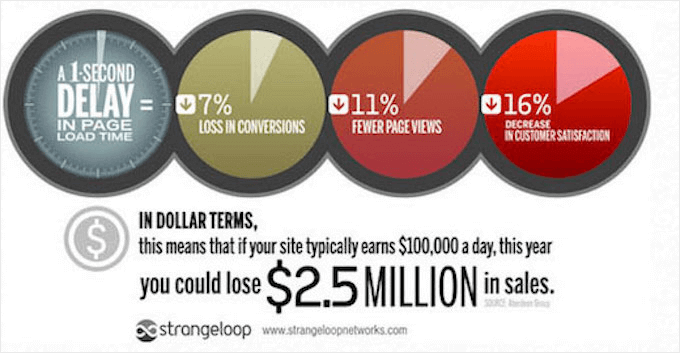
A slow website will also rank lower in search engine results. Google and other search engines penalize slower sites, which means you will get less organic traffic.
All of this means that if your website is slow, then it is essential to find out why and fix it.
How Slow Is My Website and Why?
You can quickly find out how slow your website is by running a speed test. We cover the many tools you can use in our guide on how to properly run a website speed test.
We recommend running the test at least 3 times to allow for internet fluctuations and average the results. You may also want to repeat the test using different speed test tools.
Pay special attention to the page load metric, which shows how long visitors need to wait to see your web page.
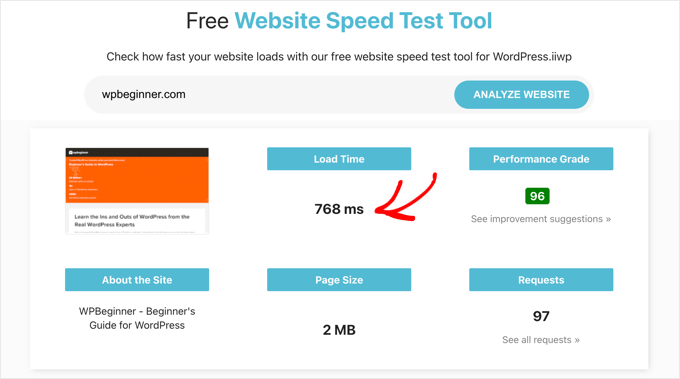
If your website takes longer than 2 seconds to load, then you need to find out what is slowing it down. Luckily, most speed test tools will highlight major problems and allow you to drill down to see detailed reports.
Now that you know the speed of your website, you need to identify any issues that are slowing it down. Fortunately, there are plenty of good ways to audit your website performance.
For example, you can use GTmetrix to improve WordPress site performance by running it as a plugin or by visiting their website to quickly run a speed test on any website.
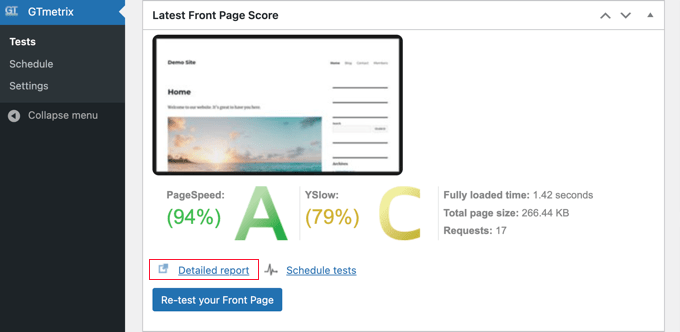
GTmetrix will give your website a score so you can quickly see how it rates.
You can also click on the ‘Detailed report’ link to learn more about potential issues. Green items don’t need your attention, while orange or red items are slowing down your site.
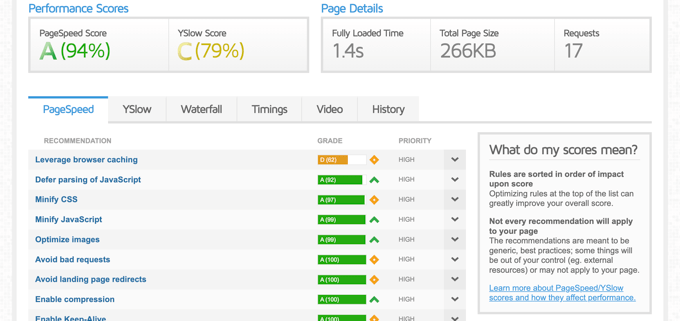
Simply clicking on an issue will tell you exactly what needs to be fixed.
With that being said, let’s take a look an in-depth look at the main issues that slow WordPress down and how to fix them:
- Your WordPress Website Is Not Up to Date
- You Are Not Using a WordPress Cache
- You Are Not Using a CDN
- Too Many Files Need to Be Loaded to View the Page
- Your Images Are Too Large or Unoptimized
- Your WordPress Database Is Unoptimized
- You Are Running Slow or Inefficient Plugins
- Your Scheduled Website Tasks Are Not Optimized
- You Are Using Slow WordPress Hosting
- Your Server Software Is Out of Date
- You Need Professional Site Speed Optimization
Your WordPress Website Is Not Up to Date
You need to make sure that your WordPress website is up to date, and that includes the WordPress software as well as your plugins and themes. Developers often release updates to optimize performance and fix bugs.
We recommend using the proper update order, starting with WordPress core and then updating your plugins and themes. You can do this conveniently from the Dashboard » Updates page in your WordPress admin area.
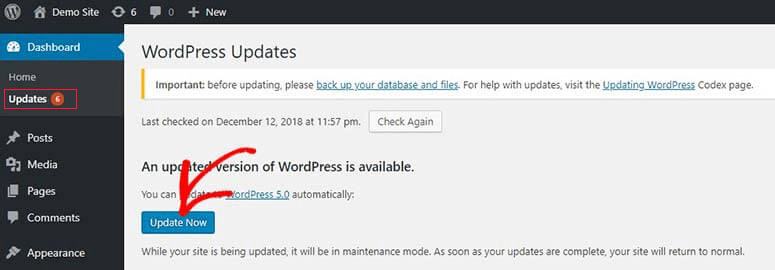
For detailed instructions, please refer to these step-by-step guides:
- Beginner’s Guide: How to Safely Update WordPress
- How to Properly Update WordPress Plugins (Step by Step)
- How to Update a WordPress Theme Without Losing Customization
You Are Not Using a WordPress Cache
Every time someone visits a page on your website, WordPress builds it dynamically from a MySQL database. This involves running scripts and querying the database, and the end result is an HTML page that can be displayed in the user’s browser.
When a large number of people visit your site at the same time, your database will receive many requests, leading to slower loading times.
A WordPress caching plugin is one of the best ways to speed up your website because it bypasses this process.
When someone visits your site, and the HTML page is generated, it is stored in a cache so that it doesn’t need to be rebuilt for future visitors. Instead, they simply view the cached page.
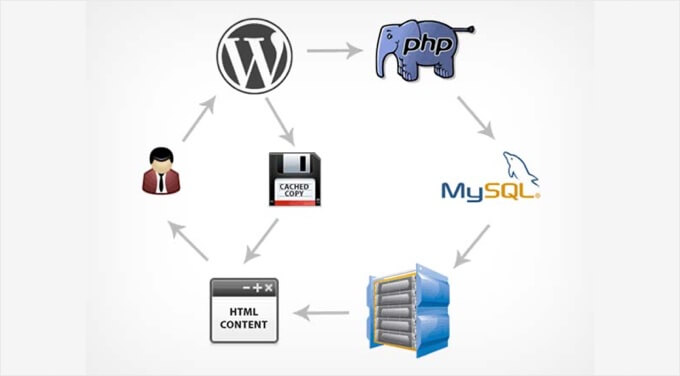
This places less load on your web server, and the page will load faster.
You can learn how to install the most popular caching plugins using these guides:
- How to Properly Install and Setup WP Rocket in WordPress
- How to Install and Setup W3 Total Cache for Beginners
- How to Install and Setup WP Super Cache for Beginners (Easy)
You can also leverage browser caching, which stores a copy of the web page and other resources on the user’s computer so it loads faster the next time they visit.
You Are Not Using a CDN
A Content Delivery Network (CDN) caches your files on multiple servers around the world. Besides caching the generated HTML pages, it also stores all of the other resources needed to view the page, including images, CSS stylesheets, JavaScript files, and more.
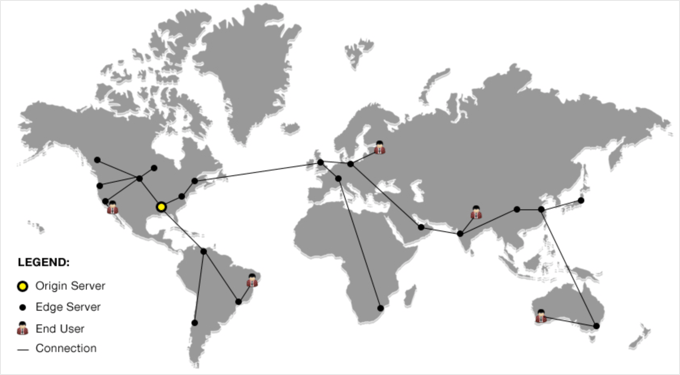
This content is served from the server closest to each user. This offers big speed gains if you have visitors from many locations around the world, as we do at WPBeginner.
If you are not already using a CDN, then you can choose from many excellent WordPress CDN services:
- We use Cloudflare because they offer a powerful WordPress CDN with a firewall to protect your site from threats.
- We also recommend Sucuri, another CDN with security features we used for many years.
- Bunny.net is an affordable option with servers spread across the world.
For more information on the benefits of a Content Delivery Network, see our guide on why you need a CDN for your WordPress blog.
Too Many Files Need to Be Loaded to View the Page
Before a visitor can view your web page, their browser first needs to request and download all of the required files. This includes all of the images you want to display, stylesheets that format the page, JavaScript files that add functionality, fonts, and more.
The more files there are, the slower the page will load, especially if some of the files are very large or are stored on a slow third-party server.
These are called HTTP requests, and we have written a detailed tutorial on how to reduce HTTP requests in WordPress.
One of the best ways to identify slow HTTP requests is with your browser’s Inspect tool. The Network tab lists the resources being loaded, and the Time column shows how long it takes each resource to load.
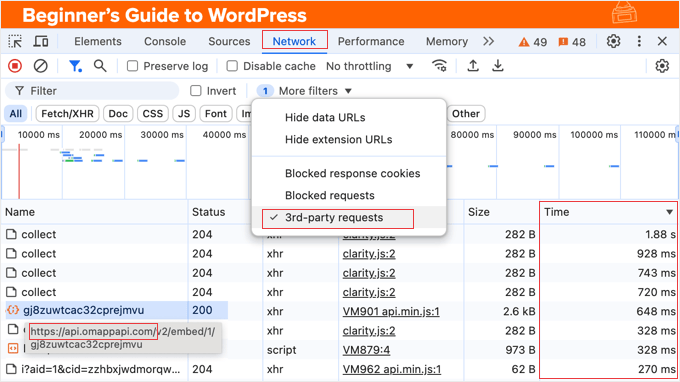
You can click the Time column’s header twice to sort the list with the slowest resources at the top. Any that takes more than half a second or a second to load may be slowing down your site, although this is just a guideline.
Let’s take a quick look at some ways you can fix this issue to speed up your website.
First, your CSS and JavaScript files often contain more information than is necessary, such as whitespace and developer comments. You can reduce the size of these files by minifying them, which makes them much faster to load.
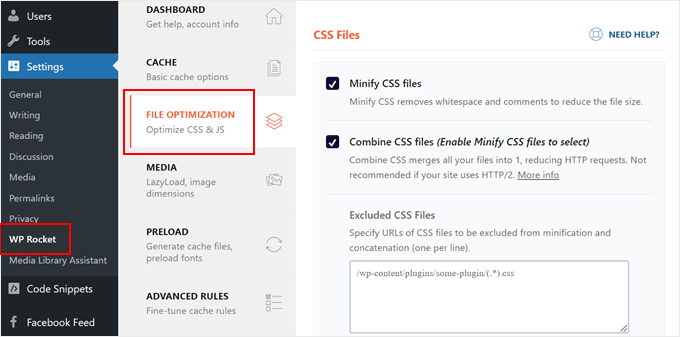
Another problem is that all of the images displayed on the entire page are being loaded, even if they won’t be visible until the user scrolls down. Lazy loading images can speed up your page load time by only loading the files that will be initially visible to the user.
You can also lazy load videos and the comment section at the bottom of the page.
You’ll find more techniques in the guide we mentioned earlier on reducing HTTP requests.
Your Images Are Too Large or Unoptimized
One of the most common speed issues we see on beginner websites is unoptimized images. In their original formats, photos and other images have huge file sizes that take a long time to load.
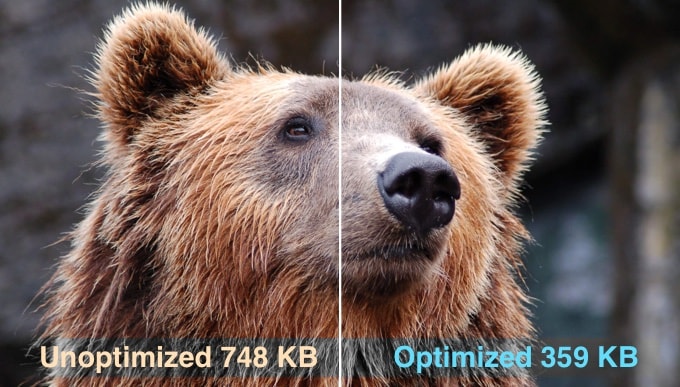
At WPBeginner, we use photo editing software to optimize our images before we upload them to our website. We resize the images to the height and width they will be displayed at on our site, tweak the image compression settings, and choose the most appropriate image format.
We aim for the smallest file size while maintaining an acceptable image quality.
For detailed instructions on optimizing your images without sacrificing quality, see our guide on how to optimize images for web performance without losing quality.
Videos take up even more space and bandwidth, so we recommend you don’t upload them to your WordPress website at all. Instead, you should use a dedicated third-party video site like YouTube and then embed the videos in your blog posts.
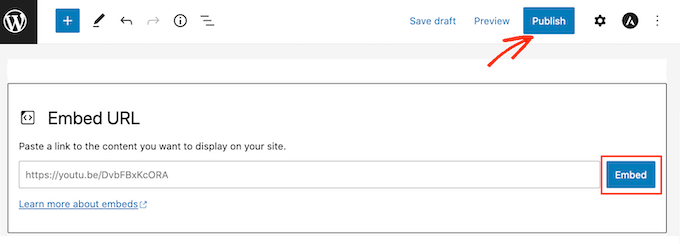
For more details, see our guide on why you should never upload a video to WordPress.
Your WordPress Database Is Unoptimized
As content is added and removed from your WordPress database over the years, it may contain a lot of unneeded information that can slow it down. This can have a serious impact on your website’s load time.
It is important to perform regular WordPress database maintenance and optimization to maintain fast website performance.
One of the best ways to clean up your database is using the WP-Optimize free version. Besides database maintenance, it can also help compress your images, remove unused image sizes, cache your content, and reduce the size of HTML, CSS, and JavaScript files.
You can choose the database management tasks you want it to perform on the WP-Optimize » Database page of your WordPress dashboard.
For example, you can improve WordPress performance by optimizing database tables, removing unnecessary post revisions, clearing auto-draft posts, and eliminating spam and trashed comments, among other tasks.

You can then run these tasks by clicking a single button at the top of the page.
For details on how to use this plugin, see our guide on how to optimize your database.
You Are Running Slow or Inefficient Plugins
Before a page on your website can be loaded, WordPress first needs to load its core files and active plugins. If a plugin loads slowly, it affects your WordPress performance.
Note that inactive plugins won’t slow down your website at all, and even having a lot of plugins installed won’t usually have a big impact on site speed. The problem is badly behaving plugins.
These are plugins that query the WordPress database more than necessary, load files from slow third-party plugins, or are simply bloated or offer more features than you need.
We have a guide on Which WordPress plugins are slowing down your site? Here, we cover a few different methods that will help you identify plugins that behave badly.
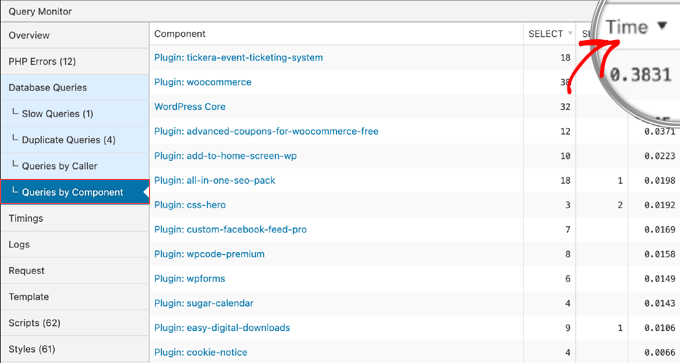
Once you have found them, you can replace them with alternative plugins that are optimized for speed or contact the plugin developer for support.
Your Scheduled Website Tasks Are Not Optimized
Some very important WordPress plugins run essential background tasks that use significant server resources and slow down your website.
Some examples include:
- Image optimization plugins perform image compression using server resources.
- Plugins that check for broken links crawl your entire website and check every link.
- Plugins that scan for malware by looking for dangerous code in your files and database.
- Backup plugins copy and compress a lot of data to keep it safe.
These tasks are necessary, so you can’t disable the plugins.
However, you can schedule these important tasks at low-traffic times when your site has fewer visitors. You can also adjust how frequently these plugins run to reduce unnecessary load on your server.

For example, if you only publish one or two articles a week, then you can schedule your backups to run just once or twice a week after the new articles have been scheduled.
You will be able to configure the schedule for each task using the plugin’s settings.
You can also see our guide on how to view and control WordPress cron jobs to learn how to configure regular tasks performed by WordPress.
You Are Using Slow WordPress Hosting
No matter how much you optimize your WordPress website, it will always be slow if you are using a slow or unreliable hosting provider. This is why we recommend that you don’t use free hosting for a live business website.
Instead, most small websites can start with a shared hosting plan with a reputable and affordable hosting company like Bluehost or Hostinger.
However, shared hosting is often too limited for larger websites with a lot of traffic, like WPBeginner. That’s why we use SiteGround’s Enterprise Cloud Infrastructure for our own website.
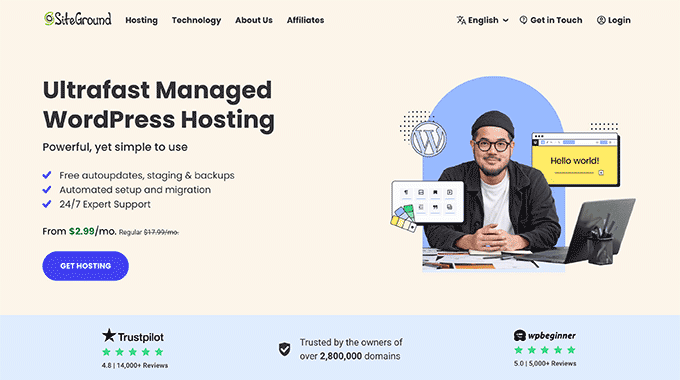
We performed thorough speed tests on the leading WordPress hosting services, including from different locations around the world, and how each provider handled a lot of traffic.
You can see the results of our performance tests in our article on the fastest WordPress hosting.
Now, changing hosting providers is a big step. So you may also want to see our guide on the top key indicators of when you should change your WordPress web hosting.
Your Server Software Is Out of Date
WordPress relies on other software to run, including the PHP programming language and MySQL database management system. This software is installed on your web server.
Like WordPress and your plugins, these programs are updated from time to time to improve performance, fix bugs and security vulnerabilities, and add new features. Using the latest version can speed up your website.
There is also a faster version of PHP that is optimized for performance, especially when your site is getting a lot of visitors.
Ultrafast PHP is an optimized version of PHP built by the SiteGround team. Since WPBeginner is hosted on SiteGround, it is one factor that improves our website speed.
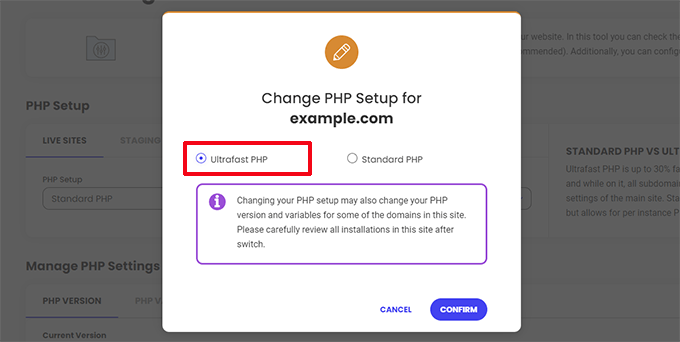
You can learn more in our guide on how fast PHP & MySQL can boost website speed.
You Need Professional Site Speed Optimization
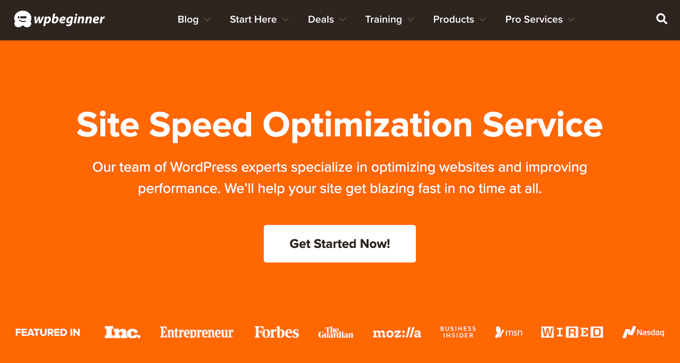
Discovering the root causes of slow websites and fixing those issues can take a lot of time, especially if you are not tech-savvy. That’s why you may need expert help from our professional Site Speed Optimization Service.
Our team will thoroughly troubleshoot your performance issues using Google Lighthouse. We will do that using a staging site, so your live site’s performance isn’t further compromised.
Based on the report, we will then take proven measures to improve your page loading time, server performance, and technical aspects of WordPress SEO, including the techniques we have covered in this article.
We also review and optimize the plugins you are using, address server optimization issues, clean up your WordPress database, handle image compression, and much more.
Plus, pricing for our site speed optimization service starts at just $699. Schedule a free call with our expert team today!
We hope this tutorial helped you learn why your WordPress website is slow and how to fix it. You may also want to see our guide on how plugins affect your site’s load time or our expert tips to improve your WordPress site health check score.
If you liked this article, then please subscribe to our YouTube Channel for WordPress video tutorials. You can also find us on Twitter and Facebook.
The post Why Is WordPress Slow? Learn How to Fix It with Our 11 Expert Tips first appeared on WPBeginner.
این خبر را در ایران وب سازان مرجع وب و فناوری دنبال کنید
مشاهده پاسخ های این مطلب
———————————————
این مطلب از سایت انجمن وردپرس گردآوری شده است و کلیه حقوق مطلق به انجمن وردپرس می باشد در صورت مغایرت و یا بروز مشکل اطلاع دهید تا حذف گردد
منبع: انجمن وردپرس